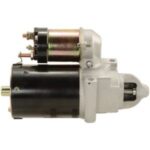When you’re shopping for car insurance, you’ll often hear the term “deductible.” But what is deductible in car insurance? Simply put, a car insurance deductible is the amount of money you agree to pay out-of-pocket when you file a claim. It’s the portion of the repair or replacement costs that you are responsible for, before your insurance coverage kicks in to pay the rest.
For example, imagine you’re involved in a minor car accident, and the total repair bill comes to $1,500. If your car insurance deductible is $500, you will pay $500, and your insurance company will cover the remaining $1,000. This shared cost responsibility is a fundamental part of how car insurance works. Understanding your deductible is crucial to making informed decisions about your car insurance policy and managing your potential financial responsibility after an accident.
Understanding How Car Insurance Deductibles Function
Typically, car insurance policies require you to choose separate deductibles for different types of coverage, specifically for comprehensive and collision coverage. It’s important to note that liability coverage, which protects you if you’re at fault in an accident and cause injury or property damage to others, does not have a deductible.
Comprehensive coverage is designed to protect your vehicle from a range of damages that are not caused by collisions. This can include events like theft, vandalism, hail damage, or damage from natural disasters. If you need to file a claim under your comprehensive coverage, your chosen deductible will apply. However, it’s worth noting that some specific comprehensive claims might not require a deductible payment, depending on your state and the nature of the damage. For instance, many insurance companies will waive the deductible for windshield repairs, particularly for minor chips or cracks.
Collision coverage comes into play when your vehicle is damaged in a collision with another vehicle or object, regardless of who is at fault (though it’s most commonly used when you are at fault). If you file a claim for damage covered by your collision insurance, you will be responsible for paying your collision deductible.
The level of deductible you choose has a direct impact on your insurance premiums. Opting for a higher deductible generally means you’ll have lower insurance premiums. This is because you are agreeing to take on a larger share of the financial burden in the event of a claim. However, remember that in an at-fault accident, this higher deductible will be an immediate out-of-pocket expense.
Conversely, selecting a lower deductible will result in higher premium payments. While you’ll pay less out-of-pocket if you file a claim, you’ll be paying more in premiums over time. If you are fortunate enough to avoid accidents and not need to file claims, you might end up paying more in total for insurance with a lower deductible compared to someone with a higher deductible over the same period.
When Do You Actually Pay Your Car Insurance Deductible?
It’s equally important to understand when you are not required to pay your car insurance deductible. Generally, you’re responsible for your deductible when you make a claim under your comprehensive or collision coverage. However, there are situations where you won’t have to pay it.
One common scenario is when you are involved in an accident where another driver is at fault. In this case, their liability insurance should cover your damages, and you typically won’t need to use your collision coverage or pay your deductible. Your insurance company may handle the claim process through a practice called subrogation to recover costs from the at-fault driver’s insurer.
Furthermore, as mentioned earlier, liability insurance claims do not involve a deductible. Liability coverage protects you from financial losses if you are responsible for an accident that injures someone else or damages their property. So, if someone makes a claim against your liability insurance, you won’t pay a deductible.
Finally, some insurance companies offer a diminishing deductible program. This type of deductible rewards safe drivers by gradually reducing their deductible amount each year they maintain a clean driving record and remain accident-free. Over time, this could lead to a significantly reduced deductible or even eliminate it altogether.
When deciding on your deductible amount, consider your comfort level with upfront costs versus ongoing monthly expenses. A higher deductible can lower your monthly insurance bill, but it also means a larger potential out-of-pocket expense if you need to file a claim.
Key Questions to Help You Choose the Right Car Insurance Deductible
Choosing the appropriate deductible can feel complicated. Here are some crucial questions to ask yourself to guide your decision:
-
How Does the Deductible Amount Affect My Premium? It’s essential to understand the relationship between deductibles and premiums. Insurance companies calculate premiums and deductible options differently, and regulations can vary by state. However, the general rule is that increasing your deductible will lower your premiums. For instance, raising your deductible from $250 to $500 could potentially reduce your collision and comprehensive coverage premiums by a significant percentage, sometimes ranging from 15% to 30%. Increasing it further to $1,000 might lead to even greater savings, possibly 40% or more. It’s wise to get quotes for different deductible levels from your insurance provider to see the exact premium impact.
-
What Are the Potential Downsides of a High Deductible? While a high deductible lowers your premium, it also means greater financial responsibility when you have to file a claim. Consider this scenario: someone scrapes your car in a parking lot, causing $900 worth of damage. If your deductible is $1,000, you’ll have to pay the entire $900 out of pocket. However, with a $250 deductible, your out-of-pocket cost would only be $250, saving you $650 in this instance. You need to be prepared to handle these larger expenses if you choose a high deductible.
-
Is a Low Deductible and Higher Premium Always Financially Worse? Not necessarily. While it might seem counterintuitive to pay more upfront in premiums, it can be beneficial depending on your circumstances. Imagine you choose a low deductible/higher premium option and go several years without filing a claim. In this case, you will have paid more in total premiums than someone who opted for a higher deductible. However, if you are more likely to file claims – perhaps you live in an area prone to accidents or have multiple drivers in your household – a lower deductible could save you money in the long run by reducing your out-of-pocket expenses when accidents do happen.
-
How Do I Decide the Best Deductible for My Situation? Consider your personal financial situation and risk tolerance. Ask yourself:
- Financial Risk Comfort: Are you comfortable with the possibility of paying a larger sum out-of-pocket if an accident occurs? Or does the idea of a potentially high deductible make you uneasy?
- Financial Capacity: Do you have sufficient savings or an emergency fund to cover the high deductible amount if needed? If you are facing financial constraints, a high deductible might seem appealing due to the lower premiums. However, ensure you could actually afford to pay that deductible if you were at fault in an accident. Building an emergency fund to cover your chosen deductible is a smart financial move before committing to a higher deductible.
-
Does My Driving History Influence Deductible Choice? Your driving record is a relevant factor. If you have a clean driving history, you might be more comfortable with a higher deductible. Statistically, you are less likely to be in an accident, so the risk of paying that higher deductible is lower. Conversely, if you have a less-than-perfect driving record, you might consider a lower deductible, despite the higher premiums. The increased likelihood of needing to file a claim could make the lower out-of-pocket expense more beneficial. Additionally, explore safe driving programs like “Vanishing Deductibles” offered by some insurers. These programs reward safe driving with deductible reductions, potentially saving you money over time while still providing lower out-of-pocket costs when you need them.
Ultimately, selecting the right car insurance deductible requires careful thought and balancing different factors. Consulting with a qualified insurance agent can be invaluable. They can provide personalized advice based on your driving record, financial situation, risk tolerance, and overall financial planning goals, helping you make the most informed decision for your car insurance needs.
https://www.bankrate.com/insurance/car/car-insurance-deductible/, Accessed December 2021.

